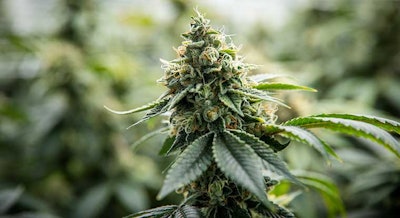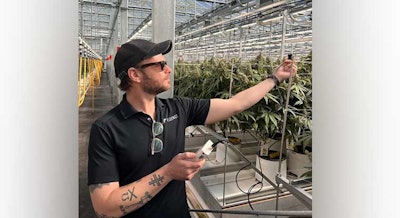
Cultivators in mature, adult-use cannabis markets such as California, Colorado, Oregon and Washington are facing a tough economic reality: if they want to continue to operate in states that have declining sales and significant price compression, they’re going to need to lower their production costs to achieve better margins and survive.
Aaron Fellabaum, product marketing manager with Fluence, which has provided light-emitting diodes (LEDs) to cannabis cultivation companies for more than a decade, said when he first started working with horticulture lighting and controlled environment agriculture (CEA) equipment sales more than 15 years ago, cultivators’ chief concerns were the efficacy of LEDs, then an unproven technology, and the spectrum, which was predominantly high red.
“In 2016, Fluence was one of the first to promote high PPFD (photosynthetic photon flex density) combined with a broader spectrum,” says Fellabaum, who has been with the company for eight years.
Now with more sophisticated lighting options, widespread adoption and published research, benefits of LEDs are proven. What is top of mind for growers these days is money, as capital is increasingly difficult to find and there are barriers to access safe, secure banking, Fellabaum says.
But it might make sense to invest in LEDs now more than ever, especially in markets with falling wholesale cannabis prices. “Given the economic downturn and introduction of horticultural specific rebates … we think there are pockets in the U.S. where it’s extremely viable to go through the process of looking at a retrofit, whether you’re trying to optimize for yield or optimize for energy usage,” he says.
There are many factors to consider when embarking on a retrofit. Here’s where cultivators can start:
1. Check your setpoints for your current mechanical systems to ensure they are working and optimized.
Depending on when a cultivation facility was built, Fellabaum says electrical grids and mechanical systems like HVAC may not have been designed specifically for cannabis cultivation, and may not be optimized, even for original lighting systems using high-pressure sodium (HPS) bulbs. Before starting any retrofit, it’s important to ensure these systems are working properly and can be adjusted for a new lighting type. Check tolerance set points for the existing HVAC.
“Are you able to run your current lights to the specification that the mechanical system was originally installed to accomplish? If you are under spec'd all year or during certain times of the year, you may find that a lower wattage LED solution is appropriate,” he says. “If there is more head room within the existing infrastructure, you could choose to either increase the light count or add in things like multi-level benching of intercanopy lighting or subcanopy lighting in order to further increase the rooms/facilities output.”

Maximizing lighting intensity helps cultivators achieve higher quality and yields. Courtesy of Fluence.
2. Consider a watt-for-watt retrofit to maximize yield.
Another option for cultivators looking to maximize the technology they have is replacing 1,000-watt bulbs with 1,000-watt LEDs to use current mechanical systems and avoid a complete overhaul. Essentially, Fellabaum says, one LED can replace one legacy light, and the same wattage can be maintained.
“If we try to fit into the mechanical engineering framework that was designed for HPS, how far we can take you is driven by whether your goal is yield optimization or reduction in energy usage. If you retrofit watt for watt, you essentially stay within that mechanical framework but optimize for yield,” Fellabaum says. “So the idea of maxing out your current mechanical system and getting as much possible yield out of that HVAC as you possibly can is generally what people are moving toward.” Of course, there are locations like California where rebates are based on a reduction in power, he adds. In these areas, your ROI might be better optimized with a mixture of both power reduction and utility incentive.
3. Optimize for lighting intensity as much as possible.
The latest cannabis research has shown that lighting intensity for cannabis doesn’t max out until about 1,500 micromoles, Fellabaum says. “If you’re under 700 micromoles, you’ve got double the amount of juice left in those plants,” he says. “If you can fit within the mechanical system, the payback based on improving revenue and yield is going to blow the operating expenditures out of the water.”
However, pushing lighting past the capabilities the original system was set up to handle would require a capital spend on upgrading other systems in the facility, which cultivators may want to avoid. And, in some states, there may be restrictions in energy usage that limit how far cultivars can push the plants.
“If you meet right in the middle where the wattage was previously, and assuming those lights are going to run at 100%, that’s going to be the closest to $0 on upgrades that you’ll need to be able to spend on that retrofit, because you’re inherently fitting into the HVAC(D) tolerance into the original system.”
4. Phase in LEDs to take pressure off capital requirements—and potentially maximize rebates.
There are a few different approaches to LED retrofits that cultivators can take, especially if they are looking to phase in the technology over time.
LEDs can be “interlaced in a checkerboard fashion,” where every other legacy light is replaced, for example, and spread across multiple years if done during HPS maintenance cycles, Fellabaum says. Completing a full retrofit over two years has a couple of advantages. One, you can split the investment over two years, and two, opportunities for rebates are often renewed every year. If the cost of half the retrofit is above the rebate cap, for example, you could receive a bigger refund by spreading out the installation.
“If you are considering a checkerboard design, ensuring that your LEDs are optically similar in terms of their beam angle or that you have enough head room to mix the two spectral compositions effectively is important,” he says. “Being able to leverage the form, fit and function of the original luminaire is a great goal to have in these scenarios.”
There are resources available to help growers find utility companies and other organizations in their areas offering rebates for companies that retrofit, including awareness.encentivizer.com and www.designlights.org. LEDs can use up to 40% less energy than traditional lighting types.

Aaron Fellabaum has been with Fluence for more than eight years. Courtesy of Fluence.
5. Reduce maintenance and labor costs.
Phasing in LEDs in a checkerboard fashion while changing out your HPS bulbs during your regular yearly maintenance/replacing cycle will save on down time. Phasing in room by room is also an option, and both can save on labor, installation and downtime costs. Reducing the time a facility needs to go through the retrofit is key to cost savings. Avoiding an electrical infrastructure upgrade is another way to save on time. For markets without significant price compression, a retrofit might not make sense, Fellabaum says.
“No one wants to undergo a construction project when a room is producing under HPS [and wholesale prices are] at $2,000 to $2,500 a pound–they’re not going to touch it until they have to,” he says. “The catch 22 is that without a really good rebate, it’s hard for people to want to invest in the down market, even though that’s specifically the time when retrofits are going to be the most viable.”
6. Note potential future challenges when weighing ROI.
Although reducing energy demands and costs are benefits of a retrofit, it’s not generally the focus – at least now, Fellabaum says. Energy prices in the U.S. are relatively low, and the payback through energy savings alone with no rebate could take up to five years. However, energy costs could go up.
And, in markets that are facing oversupply, producers can see some return out of minimizing their electrical consumption and improving their margins. This also can be an option for operators who are looking to future proof their businesses.
The key benefit of a retrofit is optimization; growers can take advantage of the technological improvements that have occurred over the past few years and improve yield, flower quality and operational savings.
7. Consider starting a retrofit in veg.
For operators who are deficient in the amount of biomass they are producing in veg, it might make sense to begin a retrofit in rooms housing plants in their vegetative growth stage. And, Fellabaum says, “Veg offers a place for people to retrofit without as much risk,” he says, noting the learning curve that LEDs require. “The best thing you can do for the growers who are going to have to learn the new technology and the ins and out of LEDs and whatever mechanical system adjustments may be needed, veg offers a more risk-adverse avenue to test it out what’s going to happen versus converting your facility as a whole.” Additionally, you may find cycle time improvements from increasing your PPFD in that stage of growth in order to improve your veg to bloom ratio if you are limited in square footage.
8. Vet your LED provider.
“Understanding where your lights are coming from, who is manufacturing them and how stable they are as a company are some of the most important things to consider,” Fellabaum says. “The big takeaway is if you are doing something at scale, make sure that the people who are supplying you with the commercial level goods that you’re purchasing will be along with you for the ride.”
To learn more about lighting retrofits and options available, visit fluence.science.


